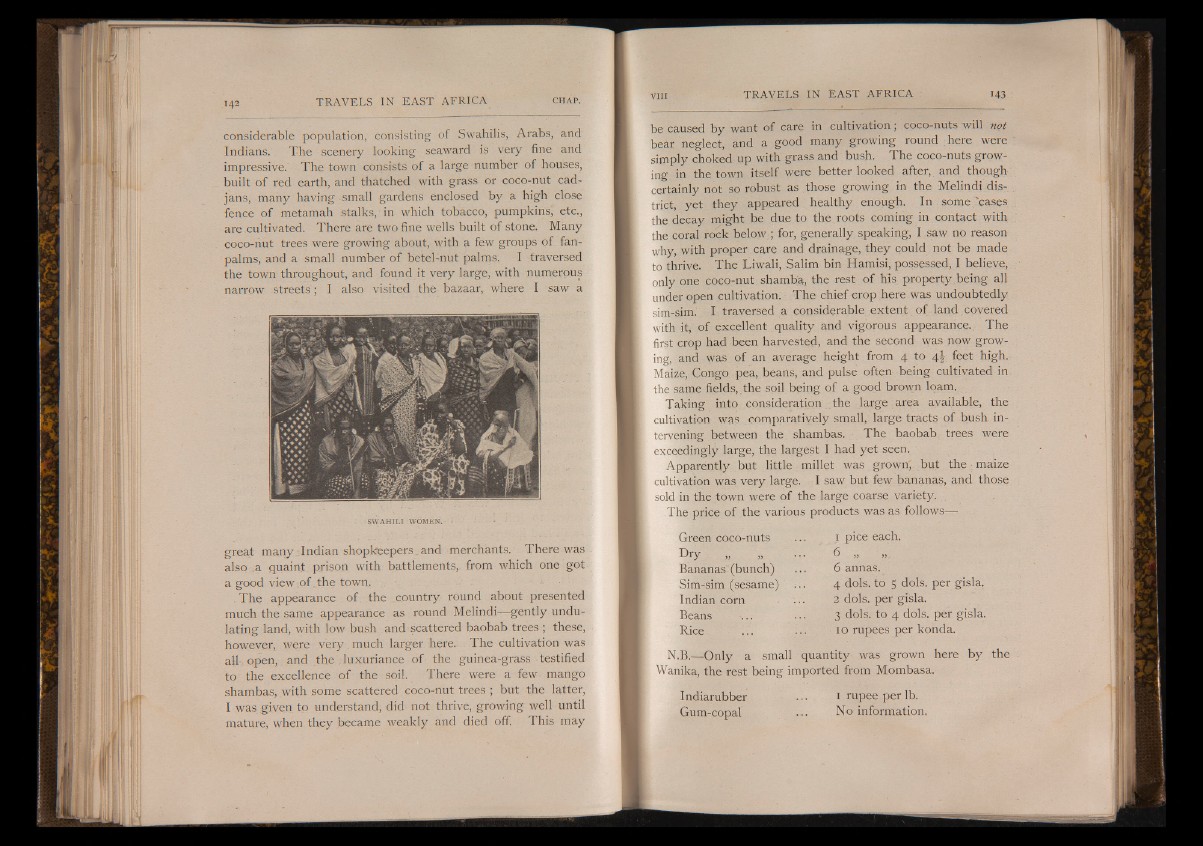
considerable population, consisting of Swahilis, Arabs, and
Indians. The scenery looking seaward is very fine and
impressive. The town consists of a large number of houses,
built of red earth, and thatched with grass or coco-nut cad-
jans, many having small gardens enclosed by a high close
fence of metamah stalks, in which tobacco, pumpkins, etc.,
are cultivated. There are two fine wells built of stone. Many
coco-nut trees were growing about, with a few groups of fan-
palms, and a small number of betel-nut palms. I traversed
the town throughout, and found it very large, with numerous
narrow streets ; I also visited the bazaar, where I saw a
SW A H IL I WOMEN.
great many.:Indian shopkeepers^ and merchants. There was
also a quaint prison with battlements, from which one got
a good view of the town.
The appearance of the country, round about presented
much the same appearance as round Melindi— gently undulating
land, with low bush and scattered baobab trees ; these,
however, were very . much larger here. The cultivation was
all open, and the luxuriance of the guinea-grass testified
to the excellence of the soil. There were a few mango
shambas, with some scattered coco-nut trees ; but the latter,
I was given to understand, did not thrive, growing well until
mature, when they became weakly and died off. This may
be caused by want of care in cultivation; coco nuts will not
bear neglect, and a good many growing round . here were
simply choked up with grass and bush. The coco-nuts growing
in the town itself were better looked after, and though-'
certainly not so robust as those growing in the Melindi district,
yet they appeared healthy enough. In some "cases
the decay might be due to the roots coming in contact with
the coral rock below ; for, generally speaking, I saw no reason
why, with proper care and drainage, they could not be made
to thrive. The Liwali, Salim bin Hamisi, possessed, I believe,
only one coco-nut shamb'a, the rest of his property.being all
under open cultivation. The chief crop here was undoubtedly
sim-sim. I traversed a considerable extent of land covered
with it, of excellent quality and vigorous appearance.. The
first crop had been harvested, and the second was now growing,
¿and was of an average height from 4 to 4J feet high.
Maize, Congo pea, beans, and pulse often being cultivated in
the same fields, the soil being of a good brown loam.
Taking into consideration the large area available, the
cultivation was comparatively small, large tracts of bush intervening
between the shambas. The baobab trees were
exceedingly large, the largest I had yet seen.
Apparently but little millet was grown, but th e ; maize
cultivation was very large. I saw but few bananas, and those
sold in the town were of the large coarse variety.
The price of the various products was as follows—
Green coco-nuts
Dry »
Bananas" (bunch)
Sim-sim (sesame)
Indian corn
Beans
Rice
1 pice each.
b „
6 annas.
4 dols. to 5 dols. per gisla.
2 dols. per gisla.
3 dols. to 4 dols. per gisla.
10 rupees per konda.
N.B.— Only a small quantity was grown here by the
Wanika. the rest being imported from Mombasa.
Indiarubber
Gum-copal
1 rupee per lb.
No information.